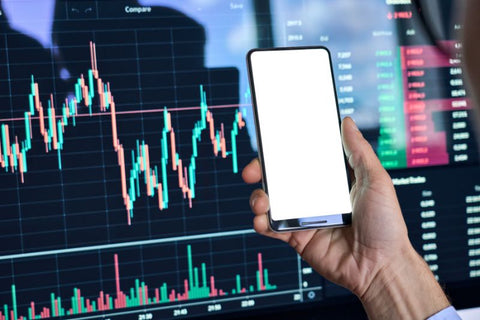Do you spend most of your life glued to your phone, television, computer, or tablet screen? If you’ve felt that familiar rising panic when you can’t locate your devices, (especially your cell) you might suffer from a little thing called hyperconnectivity.
Don’t go rushing to WebMD, it’s really common. In fact, everyone you know probably suffers from a degree of it.
Given the rise of technology over the last few decades, it’s no surprise screens have taken over our daily lives.
But what is hyperconnectivity? What are the risks and how do we disconnect?
Let’s discuss.
What is hyperconnectivity?
Hyperconnectivity is the excessive use of communication and information technologies.
This relatively recent phenomenon is of course linked to the proliferation of screens and the place they occupy in our daily lives.
If you’re constantly checking Tik Tok, Snapchat or whatever other new app the kids are using, you are probably a victim of this. Other symptoms include constantly checking messages and emails, calling people, Googling everything, listening to music, watching videos, taking photos and then posting all of it online.
The diagnosis? Hyperconnectivity!

Hyperconnectivity: The stats
We spend an average of 49 hours per week looking at screens.
That’s a lot of Fortnite.
We also look at our cell phones between 110 and 150 times a day, which actually… doesn’t seem too bad.
Although the fact it doesn’t seem too bad suggests we’re part of the problem.
According to a recent study 89% of Americans say they check their phone within 10 minutes of waking up.
That’s pretty much all of us.
The same study also revealed that 75% of us use our phone on the toilet. So you can scroll down while bearing down.
These stats really show how reliant we’ve become on screens and technology.
However, there are different types of hyperconnectivity:
- 🤓 Screens for work: Employees are constantly connected, even outside working hours, despite the right to disconnect enshrined in law. We all know it’s easier said than done.
- 💻 Cyberdependance: The compulsive and obsessive need to constantly buy and use new technologies.
- 👶Child overexposure: the most worrying connection is that between babies and screens. We’re exposing children to them too young, which can have long reaching developmental effects.
🤓Hyperconnectivity at work
Some of us really struggle to switch our brains from ‘work mode’. If that’s you, you’ve probably checked your emails out of hours, replied to messages, or even hopped back on just to “quickly fix it”.
All valuable time that could be spent playing the new Assassin’s Creed. Or quality family time… whichever you prefer.
The problem is that between remote working, digital tools, professional social networks and different timezones; there’s always a way to stay connected. Even worse, thanks to our hyperconnected world, you can be contacted at any time of day, regardless of work hours, and it takes a special type of skill to ignore this.
Although it helps if you’ve already poured a glass of wine.
🕸 Cyberdependence and internet addiction
Cyberaddiction, or internet addiction, refers to the constant need to use the internet compulsively, and often unproductively.
It is generally associated with an addiction to activities such as social media, online gaming, video streaming and any excessive use of the internet.
🖥 Overexposure to screens
Screens and hyperconnectivity are a mutual pairing.
Today, everyone is glued to their devices, whether that’s a smartphone, computer or tablet. It’s increasingly difficult to set time without screens aside, and pursue hobbies that don’t involve staring at a little, colourful, information box.
This overexposure is particularly concerning if it involves children and teenagers. They’re growing up in a different world, surrounded by constant access to technology and screens. It’s easy to get addicted fast.

How do we get hyperconnected to begin with?
There are several reasons we’re drawn to technology and become hyperconnected.
As with any other addiction, the pleasure of looking at things online, like funny dog videos, releases dopamine in the brain. The rush of feel-good endorphins encourages us to repeat this behavior.
You can be more or less sensitive to the effects dopamine has on your brain, which can affect your likelihood of becoming addicted.
Tech companies know this, they deliberately trigger your dopamine receptors to keep you engaged with their content.
Dopamine, also known as the pleasure hormone, provides instant gratification and satisfaction. It’s a fast-track quickie for your brain.
But it also has its downsides. The issue with dopamine is that you crave it, and the more you crave it, the more addicted you become.
That’s why certain activities like watching Tik Tok reels or getting likes on Instagram can feel exciting and pleasurable.
UX and UI designers build apps and sites to arouse our curiosity and sate our desires in a way that makes it impossible to resist just scrolling that little bit further. Even if it’s just to check your emails, your brain is satisfied by the flow of information.
While it all sounds a bit dangerous, it’s important to remember that these new technologies are there to make our lives easier. But they can still impact and modify our relationship with the world around us and alter our perceptions.
There are two sides to every coin.
What are the risks of hyperconnectivity?
Hyperconnectivity and overconsumption of screens can have harmful effects and impact various areas of your life. This includes mental and physical health, your relationships with others, and the development of children and adolescents.
- 🍩 Sedentary lifestyle and obesity: By constantly being on screens, we reduce physical activity. We’re all slowly turning into the people from WALL-E.
- 🧑💻 Cyberdependence: Constant connectivity leads to addiction and a dependence that becomes all encompassing. With how often we a look at screens, this can be really dangerous in the long term. They’re not the Weeping Angels from Doctor Who. We can look away.
- 🥱 Sleep disorders: Screens, and more particularly the blue light that emanates from them, affect the production of melatonin, the sleep hormone. As a result, your sleep cycle is disrupted, which can lead to insomnia and interrupted sleep patterns. It’s even worse if you played Dead By Daylight just before bed.
- 👀 Vision problems: The dangers of blue light can include long term health effects, like reduced visual acuity, blurred vision and the risk of AMD (age-related macular degeneration).
- 👁️ Digital eye fatigue: This should already be a familiar term. If you spend too long staring at screens, you can develop eye fatigue which is accompanied by lots of very unpleasant symptoms (blurred and blurred vision, dry eyes, redness and eye irritations, headaches , dizziness, etc. ).

- 😩 Neck, back and finger pain: Thanks to our overexposure to screens and hyperconnectivity, many painful physiological effects have appeared. For example, text neck syndrome, (caused by poor posture while looking at screens), back pain (also linked to poor posture) and finger pain, like tendinitis, from instant messaging too much.
- 😱 Stress: The constant influx of notifications and information via emails, social networks, messaging etc. can be a source of stress. Feeling like we need to reply instantly can cause our stress levels to rise.
- 😭 Mental health disorders such as depression, social anxiety; or dealing with FOMO (fear of missing out), and phantom vibration sensations. Our overuse of the internet and especially social media, means we are more likely to become sad, depressed or to feel alone, which can lead to depression and also social anxiety. Social anxiety, in this context, is the constant fear of missing important news or an event that would allow us to improve our social life. We then develop a certain anxiety about being offline, which is mainly found among teenagers.
Faced with the desire to stay connected, we’re also more likely to experience phantom vibrations. Our mind plays tricks on us and makes us believe that our phone is alerting us to new content, when in reality it’s just silently in our pocket. - 🧒 The impact on children’s development: Introducing screens too young can impact the physical, motor, cognitive, social and emotional development skills it’s essential children and adolescents learn.
- 🤔 Difficulties in distinguishing between professional and private life: With hyperconnectivity, employees constantly feel like they need to be available 24 hours a day. It makes it harder and harder to switch off and people are increasingly struggling to find a balance between work and family life.
- 😶🌫️ Impact on social interactions and relationships: Spending too much time on screens gradually cuts us off from the real world and others. Hyperconnected people are at greater risk of lacking interpersonal interactions, developing feelings of loneliness, and falling into social isolation.
How do we switch off from tech?
- Freeing yourself from hyperconnectivity isn’t easy, but it is doable. There are some easy steps you can take:
- ⏱️ limit your screen time: If you feel like you’ve barely looked up from your screen today and are at the risk of developing square eyes, try setting time slots. For example, only go on Instagram at set times and for no more than 10 minutes. Basically, try to stop going on social media whenever you get bored.
- 🌙 Avoid screens in the evening and especially before going to bed: Screen time in the evening can have serious consequences on your sleep cycle. We recommend limiting your screen time in the evening and completely disconnecting at least an hour and a half before bed.
- ⛔ Establish moments without phone or screen: Choose a time of day to impose a self-inflicted phone ban. That could be in the morning, during meal times or when catching up with friends. Quality time offline is important. Learn to refocus on human interactions, rather than digital ones. It's easier if you can throw the phone at the bottom of a moat with crocodiles, but if you don't have one, use a little willpower, instead. Like Thor’s hammer, your phone will still return to your grasp.

- 📵 Try a digital detox: For those who really need a break, try spending a day – or even several days – without ANY screen time at all. Your reward will be seeing the world around you, really talking with your friends, and learning what things you enjoy offline. Total disconnection guaranteed!
- 🧘 Practice non-digital activities: Go for a dog walk and leave your phone at home (this also works if you don't have a dog… the crocodiles need to come out of the moat from time to time). Take the time to do an activity without a screen (sports, cultural outing, reading, etc.) is already a big step in freeing yourself from hyperconnectivity. And what's more, it will also help reduce your general stress levels.
- 🧑💼 Only check your professional email during working hours: Stop bringing the office home; or off your kitchen table if you work from home. If you’re able to, leave your work computer at the office, or make sure it’s turned off at home. If you face objections just remember, you have a right to disconnect. And no one is paying you for this extra time.
- 🤓 Protect your eyes with anti-blue light glasses: Horus X have a great collection of blue light glasses for adults and even cooler pairs for children to counteract the harmful effects of blue light.
- 💬 Talk with young people to make them aware of the impact of the internet and screens: You might need to learn some new slang first, but it’s essential children and teens understand the impact of screens on our daily life. Through communication we can help them acquire healthy habits regarding the use of new technologies which doesn’t include 12 Halo matches in a row.
It’s also important we supervise them online so that they maintain these good practices and benefit from the advantages of screens without the associated risks. - 😍 Be the change you want to see: It may be cheesey but it’s true. You can’t yell at your kid for not pausing their campaign if you’re scrolling through your phone at the same time. Switch off and they will follow.
- 🍻 Favor reality: It's still more fun to go have a drink with your friends in a bar than to tell your life story on Tik Tok.

What is hyperconnectivity? Final thoughts
Hyperconnectivity is a disease of the modern era.
Thanks to the internet and the prevalence of screens, we’re all hyperconnected all the time. Their constant unwavering presence in our daily lives means everything revolves around screens.
However, you don’t need to be alarmed. There are simple steps to follow to learn how to unplug from time to time.
It’s important you learn to control and regulate your use of technology and above all, not let yourself become completely absorbed.
Despite all its advantages, overuse and hyperconnectivity can cause problems.
So, without going back to the Stone Age of pen and paper; learn how to manage your screen exposure. Take breaks, leave your phone at home, and try going for a walk or reading a book to free yourself from hyperconnectivity.
It’s worth it.
















